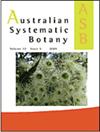海洋浮游甲藻Tripos:60年来在澳大利亚水域的物种级分布
IF 1.6
3区 生物学
Q4 EVOLUTIONARY BIOLOGY
引用次数: 3
摘要
摘要我们回顾了15772个澳大利亚物种级的海洋浮游甲藻Tripos Bory(前身为Ceratium Schrank,现在仅限于淡水物种)的记录。该属在澳大利亚热带、亚热带和温带海水以及南大洋有50多个物种和许多变种和形式。许多物种的形态存在相当大的可塑性,这混淆了物种的界定,并造成了其空间分布的不确定性。我们最近通过光学和电子显微镜展示了很少报道的Tripos hundhausenii(Schröd)Hallegr。&Huisman梳。nov.首次在阿拉伯海被描述,但在悉尼沿海水域越来越多地被观察到。大量的Tripos物种广泛分布在温带、亚热带和热带水域,在过去的60-80年里,它们在澳大利亚水域的分布保持了显著的稳定。相比之下,我们确定了一个狭窄的温水物种群,包括T.belone(Cleve)F.Gómez、T.cephalotus(Lemmerm)F.Gömez,T.dens(Ostenf.&E.J.Schmidt,很少在伊甸园、贝特曼湾或巴斯海峡发现,但偶尔会出现在塔斯马尼亚的国王岛和玛丽亚岛以南。这些罕见的热带Tripos物种被东澳大利亚洋流和列文洋流向南携带,在监测未来的范围扩张、季节性变化或热带深水的上升流或入侵时值得仔细关注。本文章由计算机程序翻译,如有差异,请以英文原文为准。
The marine planktonic dinoflagellate Tripos: 60 years of species-level distributions in Australian waters
Abstract. We reviewed 15 572 Australian species-level records of the marine planktonic dinoflagellate Tripos Bory (formerly Ceratium Schrank, a genus now restricted to freshwater species). The genus is represented by over 50 species and numerous varieties and forms in Australian tropical, subtropical and temperate marine waters and the Southern Ocean. There exists considerable plasticity in the morphology of many species, which has confounded species delimitations and created uncertainty around their spatial distributions. We newly illustrate by light and electron microscopy the rarely reported Tripos hundhausenii (Schröd.) Hallegr. & Huisman comb. nov. first described from the Arabian Sea, but increasingly being observed in Sydney coastal waters. A large number of Tripos species are widely distributed in temperate, subtropical and tropical waters and their distributions have remained remarkably stable in Australian waters over the past 60–80 years. By contrast, we identified a narrow group of warm-water species, including T. belone (Cleve) F.Gómez, T. cephalotus (Lemmerm.) F.Gómez, T. dens (Ostenf. & E.J.Schmidt) F.Gómez, T. digitatus (F.Schütt) F.Gómez, T. gravidus (Gourret) F.Gómez, T. incisus (G.Karst.) F.Gómez, T. paradoxides (Cleve) F.Gómez and T. praelongus (Lemmerm.) F.Gómez, that are commonly encountered off Sydney, rarely found down to Eden and Batemans Bay or Bass Strait, but occasionally occur as far south as King Island and Maria Island, Tasmania. These rare tropical Tripos species are carried southward by the East Australian and Leeuwin Currents and deserve careful attention in monitoring for future range expansions, changes in seasonality or upwelling or incursion of deep tropical waters.
求助全文
通过发布文献求助,成功后即可免费获取论文全文。
去求助
来源期刊

Australian Systematic Botany
生物-进化生物学
CiteScore
3.10
自引率
12.50%
发文量
12
审稿时长
>12 weeks
期刊介绍:
Australian Systematic Botany is an international journal devoted to the systematics, taxonomy, and related aspects of biogeography and evolution of all algae, fungi and plants, including fossils. Descriptive taxonomic papers should normally constitute a comprehensive treatment of a group. Short papers on individual species and nomenclatural papers must contain significant new information of broader interest to be considered. The prestigious L.A.S. Johnson Review Series is published. Other review articles will also be considered. All papers are peer reviewed.
Australian Systematic Botany is published with the endorsement of the Commonwealth Scientific and Industrial Research Organisation (CSIRO) and the Australian Academy of Science.
 求助内容:
求助内容: 应助结果提醒方式:
应助结果提醒方式:


